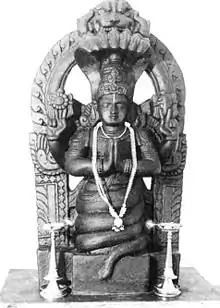Nāga
In Hinduism, Buddhism and Jainism, the Nāga (IAST: nāga; Devanāgarī: नाग) or Nagi (f. of nāga; IAST: nāgī; Devanāgarī: नागी)[1] are divine, semi-divine deities, or a semi-divine race of half-human half-serpent beings that reside in the netherworld (Patala) and can occasionally take human form. Rituals devoted to these supernatural beings have been taking place throughout south Asia for at least two thousand years.[2] They are principally depicted in three forms: wholly human with snakes on the heads and necks, common serpents, or as half-human half-snake beings.[3] A female naga is a "Nagi", "Nagin", or "Nagini". Nagaraja is seen as the king of nāgas and nāginis.[4] They are common and hold cultural significance in the mythological traditions of many South Asian and Southeast Asian cultures. They are the children of Rishi Kashyapa and Kadru.
%252C_Badami_Hindu_cave_temple_Karnataka.jpg.webp) 6th century Naga at Badami cave temples | |
| Grouping | Legendary creature |
|---|---|
| Sub grouping | Water deity, Tutelary deity, Snake deity |
| Other name(s) | Nāgī or Nāginī |
| Country | India, Nepal |
| Region | South Asia and Southeast Asia |
Etymology
| Wikispecies has information related to Naja naja. |
In Sanskrit, a nāgá (नाग) is a cobra, the Indian cobra (Naja naja). A synonym for nāgá is phaṇin (फणिन्). There are several words for "snake" in general, and one of the very commonly used ones is sarpá (सर्प). Sometimes the word nāgá is also used generically to mean "snake".[5] The word is cognate with English 'snake', Germanic: *snēk-a-, Proto-IE: *(s)nēg-o- (with s-mobile).[6]
Hinduism
The mythological serpent race that took form as cobras often can be found in Hindu iconography. The nāgas are described as the powerful, splendid, wonderful and proud semidivine race that can assume their physical form either as human, partial human-serpent or the whole serpent. Their domain is in the enchanted underworld, the underground realm filled with gems, gold and other earthly treasures called Naga-loka or Patala-loka. They are also often associated with bodies of waters — including rivers, lakes, seas, and wells — and are guardians of treasure.[7] Their power and venom made them potentially dangerous to humans. However, they often took beneficial protagonist role in Hindu mythology, such as in Samudra manthan mythology, Vasuki, a nāgarāja who abides on Shiva's neck, became the churning rope for churning of the Ocean of Milk.[8] Their eternal mortal enemies are the Garudas, the legendary semidivine birdlike-deities.[9]
Vishnu is originally portrayed in the form sheltered by Śeṣanāga or reclining on Śeṣa, but the iconography has been extended to other deities as well. The serpent is a common feature in Ganesha iconography and appears in many forms: around the neck,[10] use as a sacred thread (Sanskrit: yajñyopavīta)[11] wrapped around the stomach as a belt, held in a hand, coiled at the ankles, or as a throne.[12] Shiva is often shown garlanded with a snake.[13] Maehle (2006: p. 297) states that "Patanjali is thought to be a manifestation of the serpent of eternity".
Buddhism
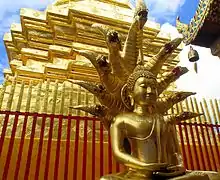
As in Hinduism, the Buddhist nāga generally has the form of a great cobra, usually with a single head but sometimes with many. At least some of the nāgas are capable of using magic powers to transform themselves into a human semblance. The nāga is sometimes portrayed as a human being with a snake or dragon extending over his head.[15] One nāga, in human form, attempted to become a monk; and when telling it that such ordination was impossible, the Buddha told it how to ensure that it would be reborn a human, and so able to become a monk.[16]
The nāgas are believed to both live on Nagaloka, among the other minor deities, and in various parts of the human-inhabited earth. Some of them are water-dwellers, living in streams or the ocean; others are earth-dwellers, living in caverns.
The nāgas are the followers of Virūpākṣa (Pāli: Virūpakkha), one of the Four Heavenly Kings who guards the western direction. They act as a guard upon Mount Sumeru, protecting the dēvas of Trāyastriṃśa from attack by the asuras.
Among the notable nāgas of Buddhist tradition is Mucalinda, Nāgarāja and protector of the Buddha. In the Vinaya Sutra (I, 3), shortly after his enlightenment, the Buddha is meditating in a forest when a great storm arises, but graciously, King Mucalinda gives shelter to the Buddha from the storm by covering the Buddha's head with his seven snake heads.[17] Then the king takes the form of a young Brahmin and renders the Buddha homage.[17]
In the Vajrayāna and Mahāsiddha traditions,[18] nāgas in their half-human form are depicted holding a nāgas-jewel, kumbhas of amrita, or a terma that had been elementally encoded by adepts.
The two chief disciples of the Buddha, Sariputta and Moggallāna are both referred to as Mahānāga or "Great nāga".[19] Some of the most important figures in Buddhist history symbolize nāgas in their names such as Dignāga, Nāgāsēna, and, although other etymons are assigned to his name, Nāgārjuna.
Literature
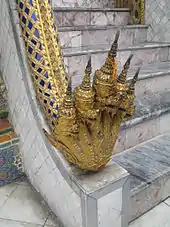
The Nāga Saṃyutta of the Pali Canon consists of suttas specifically devoted to explaining nature of the nāgas.
In the "Devadatta" chapter of the Lotus Sutra, the daughter of the dragon king, an eight year old longnü (龍女, nāgakanyā), after listening to Mañjuśrī preach the Lotus Sutra, transforms into a male Bodhisattva and immediately reaches full enlightenment.[20][21][22] Some say this tale appears to reinforce the viewpoint prevalent in Mahayana scriptures that a male body is required for Buddhahood, even if a being is so advanced in realization that they can magically transform their body at will and demonstrate the emptiness of the physical form itself.[23] However many schools of Buddhism and classical, seminal Chinese exegeses interpret the story to repudiate this viewpoint, stating the story demonstrates that women can attain Buddhahood in their current form.[20]
According to tradition, the Prajñapāramita sutras had been given by the Buddha to a great nāga who guarded them in the sea, and were conferred upon Nāgārjuna later.[24][25]
Other traditions
In Thailand and Java, the nāga is a wealthy underworld deity. For Malay sailors, nāgas are a type of dragon with many heads. In Laos they are beaked water serpents.
Sri Lanka
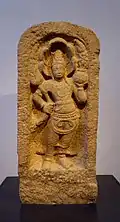
The Naga people were believed to be an ancient tribe and origins of Sri Lanka. There are references to them in several ancient text such as Mahavamsa, Manimekalai and also in other Sanskrit and Pali literature. They are generally being represented as a class of superhumans taking the form of serpents who inhabit a subterranean world. Texts such as Manimekalai represent them as persons in human form.
Cambodia
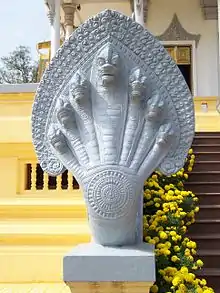
The beliefs of nagas have existed for thousands of years in the Khmer society, since the Funan Era till nowadays. There's a legend, a legend that gave birth to the Khmer people, during the Funan Era it is believed that the empire was ruled by a queen, named Queen Soma. [26] According to reports by two Chinese envoys, Kang Tai and Zhu Ying, the state of Funan in the 1st century CE, was established by the Dragon Queen and Kaundinya I. Kaundinya I was given instruction in a dream to take a magical bow from a temple in modern day Cambodia and defeat Princess Soma (Chinese: Liuye, “Willow Leaf"), the daughter of the King of the Nagas. They fell in love during a battle and she married Kaundinya I (Chinese: Huntien), their lineage became the royal dynasty of Funan. Kaundinya I later built a capital and named the country 'Kambuja'. Their love story still has a hold in modern days Cambodia, Preah Thong and Neang Neak Preah Thong (Kaundinya) holding onto Neang Neak's (Soma/Naga Princess) sbai to get to another realm (ព្រះថោងតោងស្បៃនាងនាគ), nowadays it became a tradition still continuing as a ritual in Khmer wedding ceremonies. [27] Not just weddings but there's many other Cambodian rituals that involved the Nagas like the "Dragon Monk Ordination Ceremony" (ពិធីបំបួសនាគ).[28]
The Khmer people believe they are the descendants of the Nagas or the dragons. Even if there's no proof to the existence of the Nagas, most Khmer people still believe they exist, and will one day reappear, coming back home bringing prosperity for their people.
Although many temples from the Funan Era had been destroyed through wars, nature and time; Nagas can still be seen in ancient temples from the Chenla Era and the Angkor Era. For example like the temple modern day named "The Coiled Nagas Temple" ប្រាសាទនាគព័ន្ធ (Prasat Neak Pean) used to be called, "Emperor’s Wealth Temple" ប្រាសាទរាជ្យស្រី (Prasat Reakcha Srey). [29]
Naga in the Khmer culture represents rain or a bridge between the human realm (ស្ថានមនុស្ស) and the gods/devas realm (ស្ថានទេវតា/ស្ថានសួគ៌), they can transform into half human or fully human. They act as protectors, protecting us from invisible forces, deities, other humans etc. that try to harm us. Furthermore, Cambodian naga possess numerological symbolism in the number of their heads. Odd-headed naga symbolized the Male Energy, Infinity, Timelessness, and Immortality. This is because, numerologically, all odd numbers come from One (1). Even-headed naga are said to be "Female", representing Physicality, Mortality, Temporality and the Earth. Odd headed Nagas are believed to represent Immortality and are carved and used throughout Cambodia. [30]
Odd-Headed Nagas, its Names, Origin and Connotations:
-1 Headed Naga: mostly seen in modern days; carved on objects as protection, temples, monastery, King’s residence, residence of a deity (Atitep)
Symbolizes, that even if everything in this world is gone, there’s still this Naga left bringing victory and happiness to all
-3 Kalyak: borned between the mortal realm and Devas (gods) realm, they live at the bottom of the ocean and is the guardian of wealth, often depicted as evil (nothing to do with the symbolism)
Symbolizes the Trimurti; (left Vishnu, middle Shiva and right Brahma) but also the three realm [heaven (deva realm), earth (human realm) and hell (norok realm)]. In Buddhism, the central head represents Buddha, the right head represents the Dharma and left one represents the monks.
-5 Anontak/Sesak: born out of the elemental elements on Earth, they're immortals
Symbolizes the directions; East, West, North, South and Middle (Ganges river, Indus river, Yamuna river, Brahmaputra river (Brahma's Son River), Sarasvati river). In Buddhism, the dragon heads represent the 5 Buddhas: Kadabak, Kunsontho, Koneakumno, Samnak Koudom Gautama Buddha and Seare Metrey.
-7 Muchlentak: originated from the bottom of the Himalayas, they bring peace and prosperity to humans, they're deities who control the seven oceans and seven mountains called Seytontaraksatakboriphorn. They are also the Naga that sheltered Gautama Buddha for 7 days and 7 nights. Often depicted as guardian statues, carved as balustrades on causeways leading to main Khmer temples, such as those found in Angkor Wat. [31] They also represent the seven races within Naga society, which has a mythological, or symbolic, association with "the seven colors of the rainbow".
Symbolizes the sun, the moon and five other planets; ចន្ទ (Moon)[also Monday] អង្គារ (Mars)[Tuesday] ពុធ (Mercury)[Wednesday] ព្រហស្បតិ៍ (Jupiter)[Thursday] សុក្រ (Venus)[Friday] សៅរ៍ (Saturn)[Saturday] អាទិត្យ (Sun)[Sunday]
-9 Vasukak: Is the king who rules the Earth. For this dragon, when carved on both side, the front heads represent reincarnation and the behind represent death.
Symbolizes power of the nine immortals of the universe; power of the lighting and thunder of the East (ទិសបូព៌ា), power of the fire of the Southeast (ទិសអាគ្នេយ៍), power of the law and order of the South (ទិសខាងត្បូង), power of the spirits and demonic creatures of the Southwest (ទិសនារតី), power of the rain of the West (ទិសខាងលិច), power of the wind of the Northwest (ទិសពាយព្យ), power of the wealth and aesthetic of the North (ទិសឧត្តរ), power of destruction of the Northeast (ទិសឥសាន្ត), power of Brahma (creation and preservation) in the middle.
In Brahmanism and Buddhism, there are 4 different Naga race:
1) The Primitive dragons such as the European dragon who can spit fire.
2) The Spiritual dragons who are the guardians of wealth, they protect treasure in the ocean. They can take on a half human form.
3) The Divine Nagās, who can travel to heaven, they came from Lord Indra’s realm (the divine realm), they can take on a full human form.
4) The Supreme and Divine Nagā, like Vasuki the guardian of Lord Vishnu, who alone can fight all the Garuda race. All of them have great powers and can set off storms, raining, tempest and create lands from the sea.
Indonesia
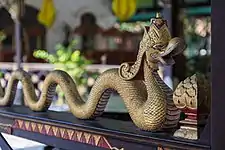
In Javanese and Balinese culture, Indonesia, a naga is depicted as a crowned, giant, magical serpent, sometimes winged. It is similarly derived from the Shiva-Hinduism tradition, merged with Javanese animism. Naga in Indonesia mainly derived and influenced by Indic tradition, combined with the native animism tradition of sacred serpents. In Sanskrit the term naga literally means snake, but in Java it normally refer to serpent deity, associated with water and fertility. In Borobudur, the nagas are depicted in their human form, but elsewhere they are depicted in animal shape.[32]
Early depictions of circa-9th-century Central Java closely resembled Indic Naga which was based on cobra imagery. During this period, naga serpents were depicted as giant cobras supporting the waterspout of yoni-lingam. The examples of naga sculpture can be found in several Javanese candis, including Prambanan, Sambisari, Ijo, and Jawi. In East Java, the Penataran temple complex contain a Candi Naga, an unusual naga temple with its Hindu-Javanese caryatids holding corpulent nagas aloft.[33]
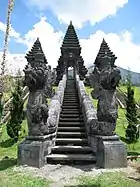
The later depiction since the 15th century, however, was slightly influenced by Chinese dragon imagery—although unlike its Chinese counterparts, Javanese and Balinese nagas do not have legs. Naga as the lesser deity of earth and water is prevalent in the Hindu period of Indonesia, before the introduction of Islam.
In Balinese tradition, nagas are often depicted battling Garuda. Intricately carved naga are found as stairs railings in bridges or stairs, such as those found in Balinese temples, Ubud monkey forest, and Taman Sari in Yogyakarta.
In a wayang theater story, a snake (naga) god named Sanghyang Anantaboga or Antaboga is a guardian deity in the bowels of the earth.[34][35] Naga symbolize the nether realm of earth or underworld.
Laos
Naga are believed to live in the Laotian stretch of the Mekong or its estuaries. Lao mythology maintains that the naga are the protectors of Vientiane, and by extension, the Lao state. The naga association was most clearly articulated during and immediately after the reign of Anouvong. An important poem from this period San Leupphasun (Lao: ສານລຶພສູນ) discusses relations between Laos and Thailand in a veiled manner, using the naga and the garuda to represent the Lao and the Thai, respectively.[36] The naga is incorporated extensively into Lao iconography, and features prominently in Lao culture throughout the length of the country, not only in Vientiane.
Thailand
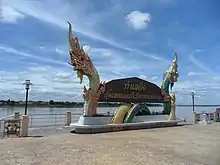
In Thai-Laotian beliefs, Nāgas are considered the patronage of water. Nāgas are believed to live in either water bodies or in caves. According to a popular legend, the Mekong River in northeastern Thailand and Laos was said to be created by two nāga kings slithering through the area, thus creating the Mekong and the nearby Nan River. The Mekong is synonymous with the unexplained fireballs phenomenon which has long been believed to be created by the nāgas that dwell in the river.[37]
Due to the strong relation with everything water, nāgas in Thai belief also plays a role in rain control. The Nak hai nam (Thai: นาคให้น้ำ; lit. nāga granting water) concept is used for annual rainfall prediction. It is still practiced nowadays, most notably during the Royal Ploughing Ceremony. The oracle ranges from 1 nak hai nam (1 naga granted water); meaning the abundant rainfall should be observed that year, to maximum 7 nak hai nam (7 nagas granted water); meaning there might not be adequate rainfall that year.[38]
In northern Thailand, the Singhanavati Kingdom had a strong connection with nāgas. The kingdom was believed to be built with aids of nāgas and thus nagas were highly reverend by the royal family. The kingdom, for a period of time, was renamed Yonok Nāga Rāj (lit. Yonok the Nagaraja)[39]
The nagas are also highly revered. The Buddhist temples and palaces are often adorned with various nagas. The term naga is also present in various Thai architecture terms including the nak sadung (นาคสะดุ้ง, the outer roof finial component featuring naga-like structure), and the nak than (นาคทันต์, the corbel with naga shape). Moreover, nagas are sometimes linked to medicine. Owing to the naga Shesha's presence in Hindu legend's Samudra manthan of which Dhanvantari (god of Indic medicine) and Amrit (healing potion) were created alongside the universe, the nagas are thus linked to medicine in some extents. The nagas can also be founded substituting the snakes in either Rod of Asclepius or mistakenly Caduceus of several medical institutions' symbols. The former seal of Faculty of Medicine, Srinakharinwirot University, and the seal of Society of Medical Student Thailand are some notable examples using the Caduceus with nagas presence instead of snakes.[40]
Malaysia
In Malay and Orang Asli traditions, the lake Chini, located in Pahang is home to a naga called Sri Gumum. Depending on legend versions, her predecessor Sri Pahang or her son left the lake and later fought a naga called Sri Kemboja. Kemboja is the Malay name for Cambodia. Like the naga legends there, there are stories about an ancient empire in lake Chini, although the stories are not linked to the naga legends.[41][42]
Philippines
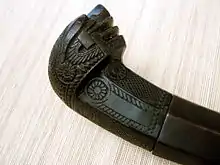
The inidgenous Bakunawa, a serpent-like moon-eating creature in Philippine mythology, was syncretized with the Nāga. It is believed to be the cause of eclipses, earthquakes, rains, and wind.[43] The movements of the bakunawa served as a geomantic calendar system for ancient Filipinos and were part of the shamanistic rituals of the babaylan. It is usually depicted with a characteristically looped tail and was variously believed to inhabit either the sea, the sky, or the underworld.[44] However, the bakunawa may have also syncretized with the Hindu deities, Rahu and Ketu, the navagraha of eclipses.[45]
Mesoamerica
The seven-headed serpent is visible on the decapitated ball player stele from the Classic Veracruz site of Aparicio (700–900 CE). Similar serpent like figures, notably the feathered-serpent, are visible throughout the Mayan religion.
Notable nāgas
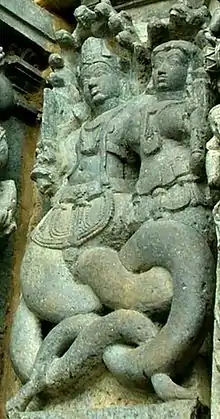
- Adishesha, on whom Vishnu is in yoga nidra (Ananta shayana)[46]
- Vasuki, the king of nagas and who coils over Lord Shiva's neck[47] and offered to serve as the rope to pull Mount Mandara in the Samudra Manthan (Churning of the Ocean of Milk) to release the Amrita (nectar of the immortality).
- Kaliya, a snake conquered by Krishna
- Manasa, the Hindu goddess of Nagas and curer of snake-bite and sister of Vasuki
- Takshaka, the tribal king of the nagas
- Ulupi, a companion of Arjuna in the epic Mahabharata
- Karkotaka, a naga king in Indian mythology who controls weather, that lived in a forest near Nishadha Kingdom and bit Nala at the request of Indra controls weather
- Mucalinda, a nāga in Buddhism who protected the Gautama Buddha from the elements after his enlightenment
- Padmavati, the Nāgī queen & companion of Dharanendra
- Apalala, Nāga in Buddhist mythology
- Shwe Nabay (Naga Medaw), a goddess or a Nat spirit in Burmese animistic mythology, who is believed to have married a Naga and died from heartbreak after he left her
- Paravataksha, his sword causes earthquakes and his roar caused thunder.
- Naga Seri Gumum, who lives in Tasik Chini, a freshwater lake in Pahang, Malaysia
- Yulong, the Dragon King of the West Sea in the Chinese classical novel Journey to the West, becomes a naga after completing his journey with Xuanzang
- Bakunawa, a dragon in Philippine mythology that is often represented as a gigantic sea serpent. Nagas are also present in Kapampangan polytheistic beliefs, such as Lakandanum. (See Deities of Philippine mythology.)
- Antaboga, the world serpent in Javanese and Balinese mythology of Indonesia, who created the world turtle Bedawang where the world resides on its back
In popular culture
- Several Bollywood films have been made about female nāgas, including Nagin (1954), Nagin (1976), Nagina (1986), Nigahen (1989), Jaani Dushman: Ek Anokhi Kahani (2002), Hisss (2010), and the television series Naaginn (2007-2009) and Naagin (2015 TV series)
- In the Telugu film Devi (1999), a Nagini played by Prema comes to Earth to protect a woman who saves her when she was in the snake form. She eventually falls in love with a human.
- In J. K. Rowling's Wizarding World, Nagini is one of Voldemort's horcruxes in the Harry Potter series and a Maledictus, a carrier of blood curse, in the film Fantastic Beasts: The Crimes of Grindlewald. Her curse allows her to change into a snake and back into a human, but her snake form eventually becomes permanent.
- In Jungle Boy, the Naga is depicted as a large cobra deity that grants the gift of understanding all languages to those who are pure of heart and punishes those who aren't pure of heart in different ways.
- The Nagas are antagonists in the cartoon The Secret Saturdays. They served the ancient Sumerian cryptid Kur and attempted to push Zak Saturday into the dark side after learning that he was Kur reincarnated, but eventually served V.V. Argost when he gained his own Kur powers.
- Nagas appear in the Dungeons & Dragons roleplaying game, depected as massive serpents with human heads.
- The Nagas appear in the Warcraft franchise. They are depicted as ancient night elves that have snake-like tails in place of legs, and have other serpentine features such as scales and fins. The Nagas came to be when they were transformed from the ancient night elves by the Old Gods.
- Nagas also appear in The Battle for Wesnoth, and are depicted as a more snakelike counterpart to the merfolk, who are often their enemies.
- Magic: The Gathering's 2014-2015 block, set on the plane of Tarkir, featured Naga as humanoid snakes versed in powerful venoms and poisons with two arms and no other appendages. They are aligned with the Sultai clan in the sets, Khans of Tarkir[48] and Fate Reforged,[49] and with the Silumgar clan in the Dragons of Tarkir[50] set.
- Naga are featured in The Silent Bells, the fourth book in N. D. Wilson's Ashtown Burials series.
Gallery
 Naga and Nagini in Bhubaneswar, Odisha
Naga and Nagini in Bhubaneswar, Odisha Naga on copper pillar in Kullu, Himachal Pradesh India
Naga on copper pillar in Kullu, Himachal Pradesh India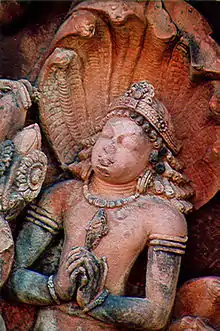 Naga king in Anjali mudra in Deogarh temple, Madhya Pradesh
Naga king in Anjali mudra in Deogarh temple, Madhya Pradesh Naga (marked 15) in the Varaha panel at Udayagiri Caves
Naga (marked 15) in the Varaha panel at Udayagiri Caves Tirthankara Parshvanatha of Jainism standing under Naga hood
Tirthankara Parshvanatha of Jainism standing under Naga hood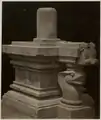 Naga supporting waterspout of Yoni-Lingam, Yogyakarta Java, c. 9th century
Naga supporting waterspout of Yoni-Lingam, Yogyakarta Java, c. 9th century.jpg.webp) Naga temple, Penataran, East Java
Naga temple, Penataran, East Java.jpg.webp) Naga bridge at Ubud monkey forest, Bali
Naga bridge at Ubud monkey forest, Bali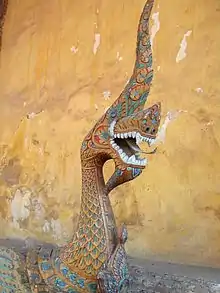
 Sesa Naga at Bangkok international airport, Thailand
Sesa Naga at Bangkok international airport, Thailand Naga at the funeral of King Bhumibol Adulyadej of Thailand in 2017
Naga at the funeral of King Bhumibol Adulyadej of Thailand in 2017
See also
References
- "Sanskrit Dictionary". sanskritdictionary.com. Retrieved 27 September 2018.
- "Nāgas". Brill’s Encyclopedia of Hinduism Online. Retrieved 9 December 2020.
- Jones, Constance; Ryan, James D. (2006). Encyclopedia of Hinduism. Infobase Publishing. p. 300. ISBN 9780816075645.
- Elgood, Heather (2000). Hinduism and the Religious Arts. London: Cassell. p. 234. ISBN 0-304-70739-2.
- Apte, Vaman Shivram (1997). The student's English-Sanskrit dictionary (3rd rev. & enl. ed.). Delhi: Motilal Banarsidass. ISBN 81-208-0299-3., p. 423. The first definition of nāgaḥ given reads "A snake in general, particularly the cobra." p.539
- Proto-IE: *(s)nēg-o-, Meaning: snake, Old Indian: nāgá- m. 'snake', Germanic: *snēk-a- m., *snak-an- m., *snak-ō f.; *snak-a- vb.: "Indo-European etymology".
- "Naga | Hindu mythology". Encyclopedia Britannica. Retrieved 11 May 2018.
- "Why was vasuki used in Samudra Manthan great ocean Churning". Hinduism Stack Exchange. Retrieved 11 May 2018.
- "Garuda | Hindu mythology". Encyclopedia Britannica. Retrieved 11 May 2018.
- For the story of wrapping Vāsuki around the neck and Śeṣa around the belly and for the name in his sahasranama as Sarpagraiveyakāṅgādaḥ ("Who has a serpent around his neck"), which refers to this standard iconographic element, see: Krishan, Yuvraj (1999), Gaņeśa: Unravelling An Enigma, Delhi: Motilal Banarsidass Publishers, ISBN 81-208-1413-4, pp=51-52.
- For text of a stone inscription dated 1470 identifying Ganesha's sacred thread as the serpent Śeṣa, see: Martin-Dubost, p. 202.
- For an overview of snake images in Ganesha iconography, see: Martin-Dubost, Paul (1997). Gaņeśa: The Enchanter of the Three Worlds. Mumbai: Project for Indian Cultural Studies. ISBN 81-900184-3-4, p. 202.
- Flood, Gavin (1996). An Introduction to Hinduism. Cambridge: Cambridge University Press. ISBN 0-521-43878-0.; p. 151
- Lange, Gerrit (26 July 2019). "Cobra Deities and Divine Cobras: The Ambiguous Animality of Nāgas". Religions. 10 (8): 454. doi:10.3390/rel10080454. ISSN 2077-1444.
- Forbes, Andrew; Henley, Daniel; Ingersoll, Ernest; Henley, David. "Indian Nagas and Draconic Prototypes". The Illustrated Book of Dragons and Dragon Lore. Cognoscenti Books. ASIN B00D959PJ0.
- Brahmavamso, Ajahn. "VINAYA The Ordination Ceremony of a Monk".
- P. 72 How Buddhism Began: The Conditioned Genesis of the Early Teachings By Richard Francis Gombrich
- Béer 1999, p. 71.
- P. 74 How Buddhism Began: The Conditioned Genesis of the Early Teachings By Richard Francis Gombrich
- Schuster, Nancy (30 June 1981). "Changing the Female Body: Wise Women and the Bodhisattva Career in Some Mahāratnakūṭasūtras". Journal of the International Association of Buddhist Studies. 4 (1): 24–69.
- Kubo Tsugunari, Yuyama Akira (tr.). The Lotus Sutra. Revised 2nd ed. Berkeley, Calif. : Numata Center for Buddhist Translation and Research, 2007. ISBN 978-1-886439-39-9, pp. 191-192
- Soka Gakkai Dictionary of Buddhism, "Devadatta Chapter"
- Peach, Lucinda Joy (2002). "Social Responsibility, Sex Change, and Salvation: Gender Justice in the Lotus Sūtra". Philosophy East and West. 52 (1): 50–74. CiteSeerX 10.1.1.820.9411. doi:10.1353/pew.2002.0003. JSTOR 1400133. S2CID 146337273. ProQuest 216882403.
- Thomas E. Donaldson (2001). Iconography of the Buddhist Sculpture of Orissa: Text. Abhinav Publications. p. 276. ISBN 978-81-7017-406-6.
- Tāranātha (Jo-nang-pa) (1990). Taranatha's History of Buddhism in India. Motilal Banarsidass. p. 384. ISBN 978-81-208-0696-2.
- https://www.phnompenhpost.com/lift/women-who-made-cambodia
- https://isaw.nyu.edu/publications/inscriptions/campa/inscriptions/C0087.html
- https://www.angkorphotographytours.com/blog/cambodia-religion/
- https://www.renown-travel.com/cambodia/angkor/neak-pean.html
- https://www.cambodiasite.nl/nagaeng.htm
- Rosen, Brenda (2009). The Mythical Creatures Bible: The Definitive Guide to Legendary Beings. Sterling Publishing Company, Inc. ISBN 9781402765360.
- Miksic, John (13 November 2012). Borobudur: Golden Tales of the Buddhas. Tuttle Publishing. ISBN 9781462909100.
- Kinney, Ann R.; Klokke, Marijke J.; Kieven, Lydia (2003). Worshiping Siva and Buddha: The Temple Art of East Java. University of Hawaii Press. ISBN 9780824827793.
- Rodemeier, Susanne (1993). Lego-lego-Platz und Naga-Darstellung . Jenseitige Kräfte im Zentrum einer Quellenstudie über die ostindonesische Insel Alor [Lego-lego Place and naga-Image; Ideas of Supernatural Power as far as Known from Publications Concerning the Eastern Indonesia Island Alor] (Thesis) (in German).
- Heinrich Zimmer: Indische Mythen und Symbole. Diederichs, Düsseldorf 1981, ISBN 3-424-00693-9
- Ngaosīvat, Mayurī; Pheuiphanh Ngaosyvathn (1998). Paths to conflagration : fifty years of diplomacy and warfare in Laos, Thailand, and Vietnam, 1778-1828. Studies on Southeast Asia. 24. Ithaca, N.Y.: Southeast Asia Program Publications, Cornell University. p. 80. ISBN 0-87727-723-0. OCLC 38909607.
- สุจิตต์ วงษ์เทศ (2 October 2019). "ตำนานกำเนิด โขง-ชี-มูล-หนองหาน สายน้ำแห่งชีวิตของคนอีสาน" (in Thai). ศิลปวัฒนธรรม.
- กิเลน ประลองเชิง (8 September 2011). "นาคให้น้ำ". ไทยรัฐ.
- มานิต วัลลิโภดม (25 October 2018). "สำรวจความเชื่อ "นาคสร้างเมืองมนุษย์" ที่ภายหลังคือเมือง "เชียงแสน"" (in Thai). ศิลปวัฒนธรiม.
-
- For the former logo of Faculty of Medicine, Srinakharinwirot University, see: File:Logo of Med SWU.gif. The fact was mentioned in the official pamphlet (2019, in Thai), and in the official introductory video (2015, in Thai)
- for the seal of the Society of Medical Students of Thailand, see: thesmst
.com
- Legends Archived 24 October 2007 at the Wayback Machine
- "Journey Malaysia » Tasik Chini". journeymalaysia.com.
- Valiente, Tito Genova (1 January 2015). "A serpent, this earth and the end of the year". BusinessMirror. ProQuest 1644507809.
- McCoy, Alfred W. (1982). "Baylan: animist religion and Philippine peasant ideology". Philippine Quarterly of Culture and Society. 10 (3): 141–194. JSTOR 29791761.
- "BAKUNAWA: The Moon Eating Dragon of Philippine Mythology". The Aswang Project. Retrieved 3 December 2019.
- Bhāgavata Purāṇa 10.1.24
- Bhāgavata Purāṇa 3.26.25
- "Planeswalker's Guide to Khans of Tarkir, Part 1". MAGIC: THE GATHERING. Retrieved 27 July 2015.
- "Planeswalker's Guide to Fate Reforged". MAGIC: THE GATHERING. Retrieved 27 July 2015.
- "Planeswalker's Guide to Dragons of Tarkir, Part 1". MAGIC: THE GATHERING. Retrieved 27 July 2015.
Further reading
- Béer, Robert (1999), The Encyclopedia of Tibetan Symbols and Motifs, Shambhala, ISBN 978-1-57062-416-2
- Müller-Ebeling, Claudia; Rätsch, Christian; Shahi, Surendra Bahadur (2002), Shamanism and Tantra in the Himalayas, Inner Traditions, ISBN 9780892819133
- Maehle, Gregor (2007), Ashtanga Yoga: Practice and Philosophy, New World Library, ISBN 978-1-57731-606-0
- Norbu, Chögyal Namkhai (1999), The Crystal and The Way of Light: Sutra, Tantra and Dzogchen, Snow Lion Publications, ISBN 1-55939-135-9
- Hāṇḍā, Omacanda (2004), Naga cults and traditions in the western Himalaya, Indus Publishing, ISBN 9788173871610
- Visser, Marinus Willem de (1913), The dragon in China and Japan, Amsterdam:J. Müller
- Vogel, J. Ph. (1926), Indian serpent-lore; or, The Nāgas in Hindu legend and art, London, A. Probsthain, ISBN 9788120610712
External links
| Wikimedia Commons has media related to Nāga. |
- Nagiana (a site dedicated to honour & remember Nagi ancestors)
- Nagas in the Pali Canon
- Nagas
- Image of a Seven-Headed Naga
- Nagas and Serpents
- Depictions of Nagas in the area of Angkor Wat in Cambodia
- Nagas and Naginis: Serpent Figures in Hinduism and Buddhism
